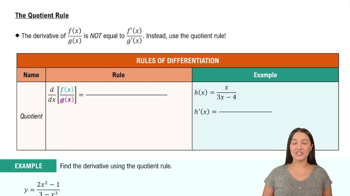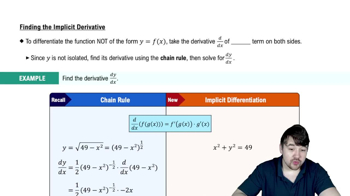Table of contents
- 0. Functions7h 52m
- Introduction to Functions16m
- Piecewise Functions10m
- Properties of Functions9m
- Common Functions1h 8m
- Transformations5m
- Combining Functions27m
- Exponent rules32m
- Exponential Functions28m
- Logarithmic Functions24m
- Properties of Logarithms34m
- Exponential & Logarithmic Equations35m
- Introduction to Trigonometric Functions38m
- Graphs of Trigonometric Functions44m
- Trigonometric Identities47m
- Inverse Trigonometric Functions48m
- 1. Limits and Continuity2h 2m
- 2. Intro to Derivatives1h 33m
- 3. Techniques of Differentiation3h 18m
- 4. Applications of Derivatives2h 38m
- 5. Graphical Applications of Derivatives6h 2m
- 6. Derivatives of Inverse, Exponential, & Logarithmic Functions2h 37m
- 7. Antiderivatives & Indefinite Integrals1h 26m
- 8. Definite Integrals4h 44m
- 9. Graphical Applications of Integrals2h 27m
- 10. Physics Applications of Integrals 2h 22m
4. Applications of Derivatives
Implicit Differentiation
Problem 120a
Textbook Question
Let f(x) = x².
a. Show that f(x)−f(y) / x−y = f′(x+y²), for all x≠y.
 Verified step by step guidance
Verified step by step guidance1
Start by understanding the problem: We need to show that the difference quotient (f(x) - f(y)) / (x - y) is equal to the derivative of f evaluated at (x + y²).
First, calculate f(x) and f(y) using the given function f(x) = x². This gives us f(x) = x² and f(y) = y².
Substitute these into the difference quotient: (f(x) - f(y)) / (x - y) = (x² - y²) / (x - y).
Recognize that x² - y² is a difference of squares, which can be factored as (x - y)(x + y). Substitute this into the difference quotient to simplify: ((x - y)(x + y)) / (x - y).
Cancel the (x - y) terms in the numerator and denominator, assuming x ≠ y, to get x + y. Now, find the derivative f'(x) = 2x, and evaluate it at x + y²: f'(x + y²) = 2(x + y²). Compare this with the simplified expression x + y to verify the equality.
 Verified video answer for a similar problem:
Verified video answer for a similar problem:This video solution was recommended by our tutors as helpful for the problem above
Video duration:
2mPlay a video:
Was this helpful?
Key Concepts
Here are the essential concepts you must grasp in order to answer the question correctly.
Difference Quotient
The difference quotient is a fundamental concept in calculus that represents the average rate of change of a function over an interval. It is defined as (f(x) - f(y)) / (x - y) for x ≠ y. This expression is crucial for understanding the derivative, as it approaches the instantaneous rate of change as y approaches x.
Recommended video:

The Quotient Rule
Derivative
The derivative of a function at a point measures how the function's output changes as its input changes. It is denoted as f'(x) and can be interpreted as the slope of the tangent line to the function's graph at that point. In this question, we need to show that the difference quotient equals the derivative of f at a specific point, which involves applying the definition of the derivative.
Recommended video:

Derivatives
Function Composition
Function composition involves combining two functions to create a new function, where the output of one function becomes the input of another. In this context, we need to evaluate f' at (x + y²), which requires understanding how to apply the derivative to a function that is itself a composition of variables. This concept is essential for manipulating and simplifying expressions involving derivatives.
Recommended video:

Evaluate Composite Functions - Special Cases

 5:14m
5:14mWatch next
Master Finding The Implicit Derivative with a bite sized video explanation from Nick
Start learningRelated Videos
Related Practice



